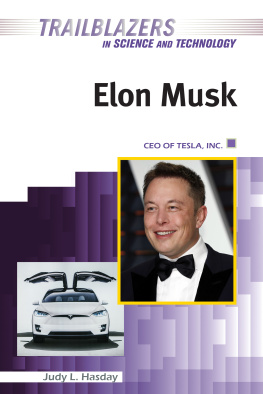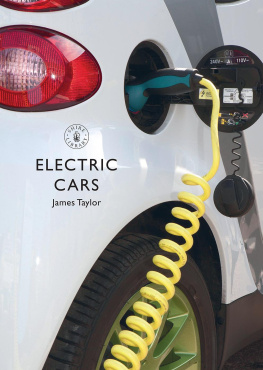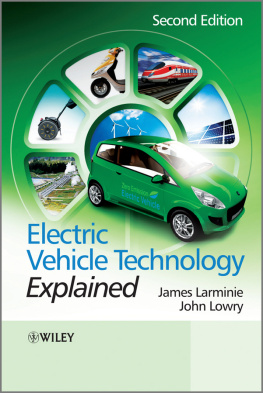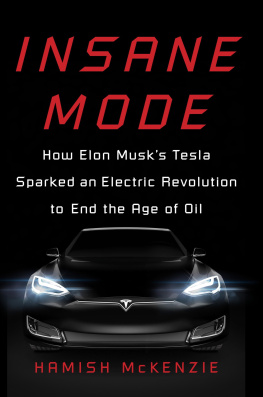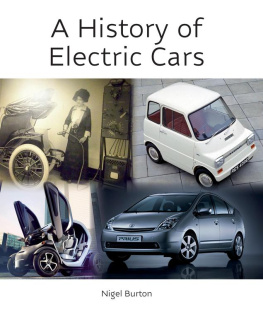Contents
Guide

The author and publisher have provided this e-book to you for your personal use only. You may not make this e-book publicly available in any way. Copyright infringement is against the law. If you believe the copy of this e-book you are reading infringes on the authors copyright, please notify the publisher at: us.macmillanusa.com/piracy.
To Ron Goldfarb:
There is nothing better for a writer of books on off-beat subjects than an agent who loves to go fishing.
There are few technological adventure stories that are as rich, quirky, and peculiarly American as the early rise, the precipitous fall, and the modern resurgence of the electric car. If you are one of the millions of buyers who are now considering an electric vehicle, you should know that this car, like the lead character in a movie, has an intriguing backstory.
Peering out at you from the showroom window is a creature that is a product of enormous risks, long, frustrating struggles, dismal failure leading almost to its extinction, an unlikely resurrection, and finally a list of improbable victories. They include little wins that are happening daily as hundreds of thousands of car buyers begin to break buying habits that have dominated the economy for almost a century.
You have probably never been in love with your toaster or your refrigerator, but here is an electric appliance that might seduce you. Many Americans have fallen in love with their cars. Our countrys varicose network of highways was built for them. They have created millions of jobs, helped erect a robust manufacturing base, and generated a freedom of travel that is unparalleled in the world.
And they have also caused traffic congestion, pollution, noise, and a costly, sometimes dangerous reliance on imported oil. Then there are the carbon dioxide emissions that have convinced most scientists that our planet will become dangerously overheated unless we do something to minimize the emissions.
The electric vehicle that youre looking at may be your way of trying to help solve some of these problems. It may just be a quest for a reliable, fuel-saving set of wheels. Or it may scratch that itch for performance that youve had for years. When you have to move, this car will give you a burst of silent power that you have probably never experienced.
The current electric vehicles are carefully designed not to shock you, but the sticker price on the rear window might. It may be higher than you have bargained for, but measured over the lifetime of these cars, the costs are likely to be cheaper than the other cars you have enjoyed or fantasized about owning. Cars, like a lot of the items you own, arrive with hidden costs.
The last razor or computer printer you bought came with a price tag that was deceptively cheap, but they subjected you to long investments in expensive blades and printer ink. The last car you bought exposed you to volatile gasoline prices and, possibly, a long relationship with your auto dealers service department that you didnt expect and didnt budget for.
Well, think of the hybrid-electric or plug-in electric or fuel cell electric vehicle that may have aroused your curiosity as a kind of superhero, a track-tested revolutionary that has come to save you from some of the hidden costs. Because they have fewer moving parts, are more energy-efficient, and can run on cheaper, cleaner fuel, electric vehicles are creating a lengthening record of reliability and economic satisfaction that many drivers are now discovering.
Think of them as Indiana Jones on wheels. They are the product of thousands of adventurers, inventors, hot rodders, engineers, and risk takers who have relied mainly on Americas high technology to challenge the auto industrys status quo. You need to do more than kick the tires to grasp the promise of these cars. but once you do, they will very likely give you a kick.
The roots of the first generation of electrics go directly back to one of the founders of the nation: Ben Franklin. His early experiments with electricity attracted a worldwide following that included a minor eighteenth-century Italian aristocrat, a reclusive dreamer named Alessandro Volta.
Volta, a public school administrator who fancied himself a physicist, was proud to describe himself as a Franklinist. He performed magic tricks using static electricity and wrote poems in Latin and lyrical papers on electricitys mysterious properties and its possible future uses. When he described electricity as a miraculously invisible liquid, one of his mentors felt he had gone off the rails of science. He ordered Volta to keep silent forever.
Instead, Volta went back to his lab. In 1799 he built a stack of silver coins, interspersing them with poker chipsized pieces of zinc and circular pieces of water-soaked cardboard. After he soaked his hands in water and then grasped both ends of this strange apparatus, he was rewarded with a substantial electric shock. He had invented the first storage battery.
The discovery brought him worldwide honors, including a medal from Napoleon, and immortality as a unit measuring the potential carrying capacity of a line connected to an electric current: the volt. Alas, Count Volta never fully understood the complex electro-chemical reaction that made his invention work. He has that in common with thousands of other pioneers who have spent their lives trying to fathom the continuing mysteries and quirks of batteries.
The pioneers work eventually led to the Electrobat, a black, 1,650-pound coffin-shaped vehicle carrying on its skinny wheels a battery derived from those that powered Philadelphias streetcars. It made its stunningly silent appearance on the lakefront in Chicago on Thanksgiving Day 1895. Electrobat was one of the standouts of the nations first automobile race, even though it ran out of juice before the finish line and lost to a pack of noisy, fume-belching, gasoline-powered cars. The judges were so impressed they gave it an award for appearance.
Still, there were businessmen who saw electrics as the future. By 1900, the Electrobat morphed into the Mark XVII hansom cab. Although their batteries weighed nearly a ton, hundreds of these cabs zipped soundlessly along Manhattan streets at twenty miles per hour. They worked longer hours than horses could and did not poop on the streets. Plus, they provided an exotic thrill to passengers accustomed for generations to looking from the coach at the slowly churning backside of an animal.
There is a sense of incompleteness about it, marveled Cholly Knickerbocker, a columnist for the New York Journal-American . You seem to be sitting on the end of a huge pushcart propelled by an invisible force and guided by a hidden hand.
Most important, these cars made money. By the turn of the century more than twenty-seven manufacturers were making electrics. Among the leading customers creating the demand were society women, who disliked arriving at a reception in a cloud of dust in a vehicle propelled by explosions and steered either by a goggled chauffer or the man of the house.
The electrics offered a salonlike quiet and luxury refinements, including glassed-in enclosures, carved wood interiors, crystal flower vases, even patent leather fenders. Moreover, to go out for a spin, the woman did not have to negotiate with the chauffeur or her husband. She simply climbed in, pushed a button, and drove off.
Margaret Whitehead, the reigning society queen of Denver, drove her electric to opening nights, stepping out of her car perfectly composed to make her entre. One can wear the most perishable and delicately hued gown she possesses, she explained, and the daintiest of footwear without giving it a thought, for when she arrives at her destination, she is unsullied and her coiffure is as unruffled as it was when she left home.


